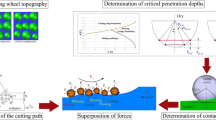Abstract
Increasing competition and short product life cycles make it necessary to optimize and evaluate the outcome of manufacturing processes. In tool grinding, models for the final workpiece geometry and cutting forces are of particular interest. To establish a valid general grinding model, we investigated the cutting process and the influence of local grinding wheel engagements on the material removal. We consequently developed models of material removal and grinding wheel topography, which capture the main correlations in grinding. In combination, temporal cutting forces and final workpiece geometry are predictable and are in excellent agreement with experimental data. The introduced models are valid for grinding in general, since they are solely based on the geometry and process parameters, and hence are applicable for manufacturing process optimization.
Similar content being viewed by others
References
Altintas Y, Brecher C, Weck M, Witt S (2005) Virtual machine tool. CIRP Ann Manuf Technol 54 (2):115–138. doi:10.1016/S0007-8506(07)60022-5 10.1016/S0007-8506(07)60022-5
Biermann D, Blum H, Jansen T, Rademacher A, Scheidler A V, Schröder A, Weinert K (2008) Space adaptive finite element methods for dynamic signorini problems in the simulation of the NC-shape grinding process. In: Proceedings of the 1st CIRP international conference on process machine interactions, pp 309–316
Brecher C, Esser M, Witt S (2009) Interaction of manufacturing process and machine tool. Ann CIRP 58(2):588–607. doi:10.1016/j.cirp.2009.09.005
Brinksmeier E, Aurich J, Govekar E, Heinzel C, Hoffmeister H W, Klocke F, Peters J, Rentsch R, Stephenson D, Uhlmann E, Weinert K, Wittmann M (2006) Advances in modeling and simulation of grinding processes. CIRP Ann Manuf Technol 55(2):667–696. doi:10.1016/j.cirp.2006.10.003
Chang H C, Wang J J J (2008) A stochastic grinding force model considering random grit distribution. Int J Mach Tools Manuf 48 (12–13):1335–1344. doi:10.1016/j.ijmachtools.2008.05.012 10.1016/j.ijmachtools.2008.05.012
Chen X, Rowe W B (1996a) Analysis and simulation of the grinding process. Part I: generation of the grinding wheel surface. Int J Mach Tools Manuf 36(8):871–882. doi:10.1016/0890-6955(96)00116-2
Chen X, Rowe W B (1996b) Analysis and simulation of the grinding process. Part II: mechanics of grinding. Int J Mach Tools Manuf 36 (8):883–896. doi:10.1016/0890-6955(96)00117-4 10.1016/0890-6955(96)00117-4
Chen X, Rowe W B (1996c) Analysis and simulation of the grinding process. Part III comparison with experiment. Int J Mach Tools Manuf 36(8):897–906. doi:10.1016/S0007-8506(07)62939-4
Chen X, Rowe W B (1998) Analysis and simulation of the grinding process. Part IV: effects of wheel wear. Int J Mach Tools Manuf 38(1–2):41–49. doi:10.1016/S0007-8506(07)62939-4
Chen Y (1990) Untersuchungen über Schwingungen und Welligkeiten beim Außenrundeinstechschleifen [Analysis of vibration and waviness of external plunge-cut grinding], PhD thesis, Universität Hannover
Cooper W L, Lavine A S (2000) Grinding process size effect and kinematics numerical analysis. J Manuf Sci Eng 122(1):59–69. doi:10.1115/1.538888
Deichmueller M, Denkena B, de Payrebrune KM, Kröger M, Wiedemann S, Schröder A, Carstensen C (2013) Modeling of process machine interactions in tool grinding. In: Denkena B, Hollmann F (eds) Process machine interactions, lecture notes in production engineering. doi:10.1007/978-3-642-32448-2_7. Springer, Berlin, pp 143–176
Ernst W (1965) Erhöhte Schnittgeschwindigkeit beim Aussen- und Einstechschleifen und ihr Einfluss auf das Schleifergebnis und die Wirtschaftlichkeit [Increased cutting speed for external and plunge-cut grinding and its influence on the grinding result and the economy], PhD thesis, RWTH Aachen
Fritz A H, Schulze G (2010) Fertigungstechnik [Manufacturing Technology]. Springer-Lehrbuch, Berlin. doi:10.1007/978-3-642-12879-0 10.1007/978-3-642-12879-0
Inasaki I (1996) Grinding process simulation based on the wheel topography measurement. CIRP Ann Manuf Technol 45(1):347–350. doi:10.1016/S0007-8506(07)63077-7
Kassen G, Werner G (1969a) Kinematische Kenngrößen des Schleifvorgangs: Teil 1 [Kinematical parameters for grinding: part 1]. Industrieanzeiger 91(87):2087–2090
Kassen G, Werner G (1969b) Kinematische Kenngrößen des Schleifvorgangs: Teil 2 [Kinematical parameters for grinding: part 2]. Industrieanzeiger 91(95):2323–2326
Klocke F (2005) Fertigungsverfahren 2 [Manufacturing Processes 2]. In: VDI-Buch. 4th edn. Springer, Berlin, DOI 10.1007/3-540-27699-8, (to appear in print)
Klocke F, Kuchle A (2009) Manufacturing processes 2: grinding, honing, lapping. RWTH edition. Springer, Berlin
Klocke F, Beck T, Hoppe S, Krieg T, Müiller N, Nöthe T, Raedt HW, Sweeney K (2002) Examples of FEM application in manufacturing technology. J Mater Process Technol 120(1–3):450–457. doi:10.1016/S0924-0136(01)01210-9
Nguyen T, Butler D (2005a) Simulation of precision grinding process, Part 1: generation of the grinding wheel surface. Int J Mach Tools Manuf 45(11):1321–1328. doi:10.1016/j.ijmachtools.2005.01.005 10.1016/j.ijmachtools.2005.01.005
Nguyen T, Butler D (2005b) Simulation of surface grinding process, Part 2: interaction of the abrasive grain with the workpiece. Int J Mach Tools Manuf 45(11):1329–1336. doi:10.1016/j.ijmachtools.2005.01.006
de Payrebrune KM (2015) Dynamical aspects in modeling long cantilevering workpieces in tool grinding. J Sound Vibr 355:407–417. doi:10.1016/j.jsv.2015.06.027
Reichenbach G, Mayer J, Kalpakcioglu S, Shaw M (1956) The role of the chip thickness in grinding. Trans ASME:78
Saint-Gobain Diamantwerkzeuge GmbH (Accessed 1st November 2015) Homepage: http://www.winter-superabrasives.com
Tönshoff H, Denkena B, Jacobsen J, Heimann B, Schütte O, Grudzinski K, Bodnar A (2004) Nonlinear dynamics of an external cylindrical grinding system and a strategy for chatter compensation. Nonlin Dyn Product Syst:187–207
Tönshoff HK, Denkena B (2013) Basics of cutting and abrasive processes. Springer
Warnecke G, Zitt U (1998) Kinematic simulation for analyzing and predicting high-performance grinding processes. CIRP Ann Manuf Technol 47 (1):265–270. doi:10.1016/S0007-8506(07)62831-5 10.1016/S0007-8506(07)62831-5
Weck M, Hennes N, Schulz A (2001) Dynamic behaviour of cylindrical traverse grinding processes. CIRP Ann Manuf Technol 50(1):213–216. doi:10.1016/S0007-8506(07)62107-6
Zhou X, Xi F (2002) Modeling and predicting surface roughness of the grinding process. Int J Mach Tools Manuf 42(8):969–977. doi:10.1016/S0890-6955(02)00011-1
Author information
Authors and Affiliations
Corresponding author
Rights and permissions
About this article
Cite this article
de Payrebrune, K.M., Kröger, M. Reduced models of grinding wheel topography and material removal to simulate dynamical aspects in grinding. Int J Adv Manuf Technol 88, 33–43 (2017). https://doi.org/10.1007/s00170-016-8694-1
Received:
Accepted:
Published:
Issue Date:
DOI: https://doi.org/10.1007/s00170-016-8694-1




